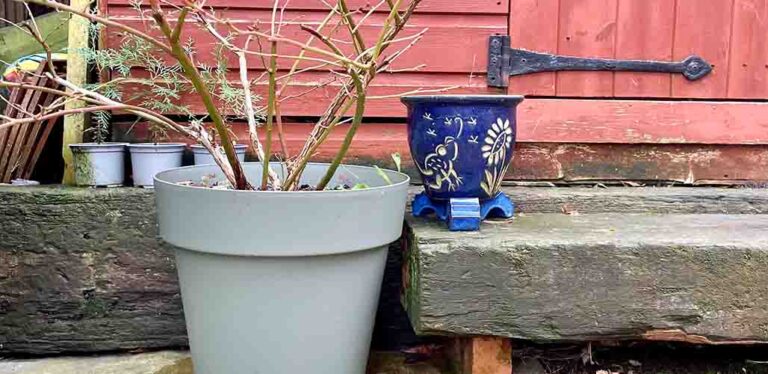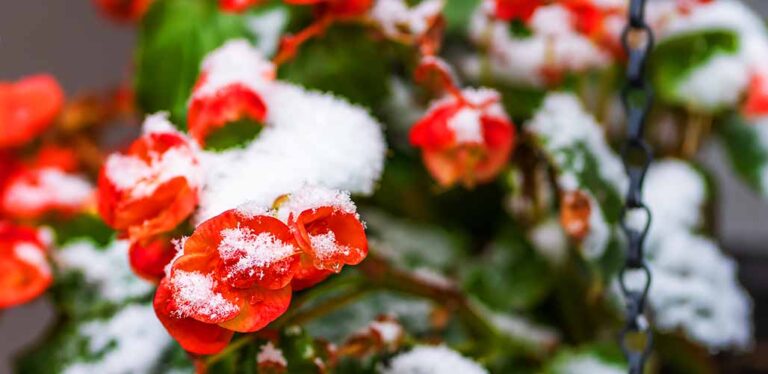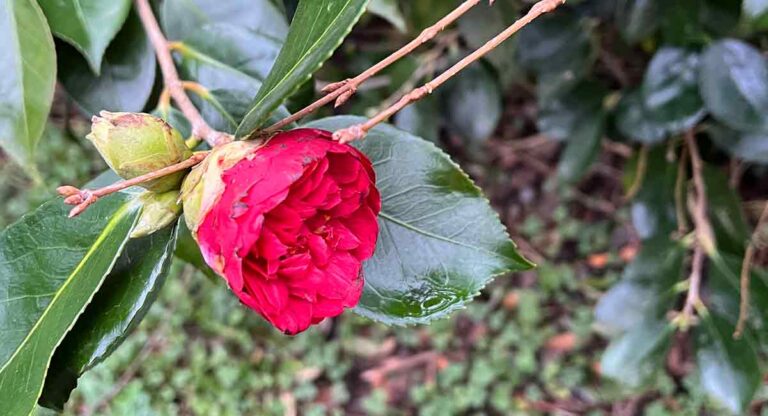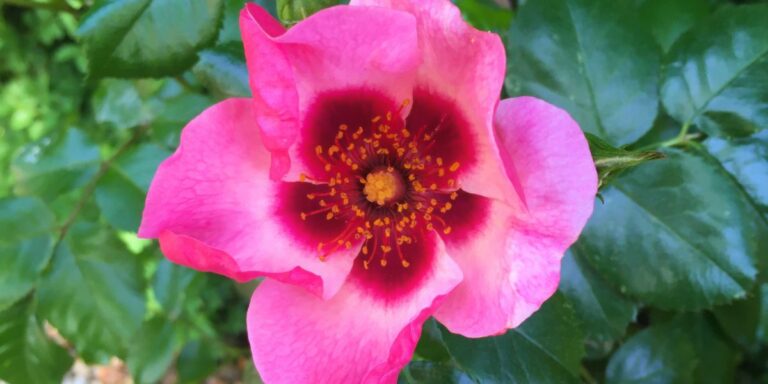Growing Hostas In A Pot Or Container
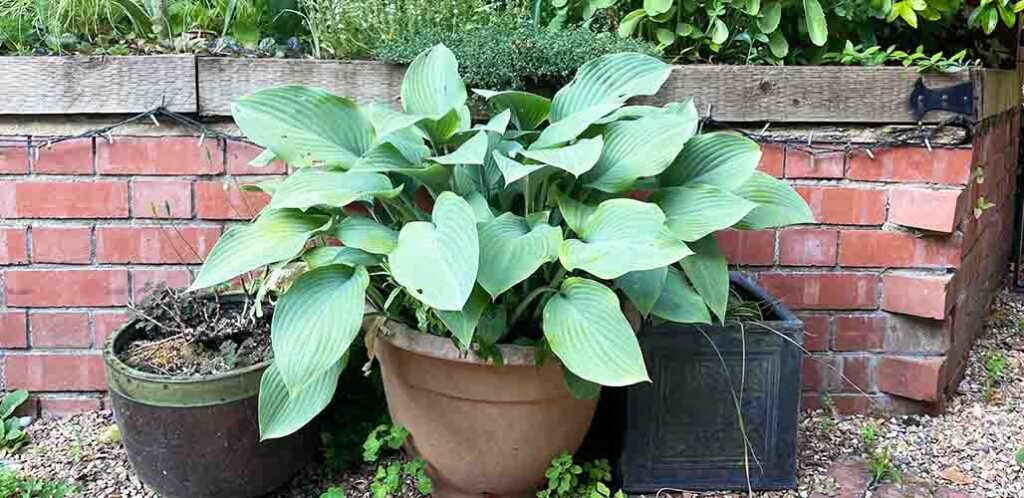
The biggest benefit of growing hostas in a pot or container of some sort, is reduction in slug damage. Hostas are extremely attractive to slugs and unless you live in a fairly dry zone, growing hostas means going to war with slugs. Growing your hosta in a pot won’t eliminate this problem entirely but it really does make a big difference. Especially in the early stages of growth when the plants are at their most vulnerable.
Hostas are often used for ground cover under trees and shrubs because they love dappled light and shady locations. But they also thrive in tubs and pots. And will tolerate quite a bit of sunshine for part of the day. They are flowering plants, but they are most famous for their foliage, which comes in a wide variety of colors and shapes. So if your beds are full, here’s how to squeeze a few more hostas into your garden by growing them in containers and planters!
Contents
- Why try growing hostas in a pot or container?
- Choosing a container
- The best hosta varieties for growing in pots
- How to plant your container
- Keeping your potted hostas looking their best
Why try growing hostas in a pot or container?
Apart from the reduction in slug damage, a container can be a great way to keep and display your hostas. It enables you to tuck them out of sight while they’re dormant, and show them off in a prominent spot when they’re at their best. It also creates flexibility to stop large-leaved hostas overwhelming smaller plants, and avoid mini hostas being swamped by bigger plants. If you’d like to grow one of the hostas with dramatic red stems, growing them in a container on a table or other raised spot will show off their most exciting feature closer to eye-level.
When you grow your hostas in a pot you can also add a strip of copper tape around the pot for extra slug protection. When the tape is high enough up the pot, the leaves will hide it as the hosta grows and starts to drape over the sides. Alternatively you can mulch the top of the planter with sharp grit, safe in the knowledge it won’t get disturbed or washed away.
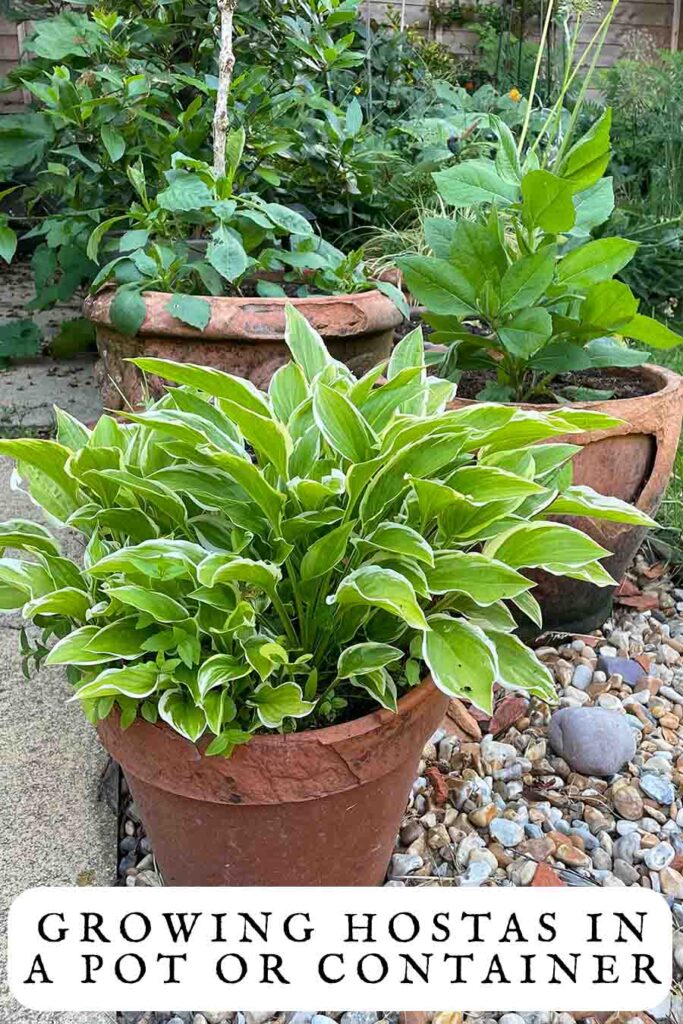
Choosing a container
You can grow a hosta in just about any vessel. For small and shallow planters, choose mini hostas, and for larger containers choose small or medium varieties. If in doubt, plant your hosta in a pot that is equal to it in height. Not only is this more balanced on the eye, it guarantees your plant’s roots will have enough room. When planting mini or small varieties, bear in mind that small pots dry out much faster than large ones. It is easier to grow several tiny hostas in one large pot (or grow them alongside other container plants) than to grow them in multiple small pots.
In winter, your hosta will be hardy down to a frigid -40°F, but lots of planters aren’t. So look for containers that can tolerate your climate. Unglazed terracotta pots are very susceptible to frost damage, as you can see in the photo above. Since the pot is porous, it cracked when water permeated it and then froze over winter. It is holding on for dear life, but I will need to replace it soon! More frost-proof options include glazed clay pots, zinc planters, or modern plastic containers.
Besides traditional plants pots, some creative containers for hostas include:
- Tiered strawberry planters (perfect for showing off several types of mini hosta).
- Wooden bottle cases lined with permeable membrane.
- Old buckets or wheelbarrows with holes drilled in the bottom.
- Thrifted enamel pans and colanders.
- Outgrown children’s sand and water tables.
The best hosta varieties for growing in pots
There are several hundred hosta varieties recognised by the American Hosta Society. It’s easy for nurseries and even enthusiastic hosta fans to create new varieties by cross-pollinating two existing varieties, then producing clones of their favorite results by dividing the crown or taking tissue cultures. Hosta types are divided into 5 categories by size: miniature, small, medium, large and giant. Mini, small and medium are the easiest to grow in containers. The size thresholds for these categories are:
- Mini: Under 8 inches tall
- Small: 9 to 14 inches tall
- Medium: 15 to 22 inches tall
10 varieties to try
So there is an almost dizzying number of hosta cultivars small enough to fit in a container, and if choosing between them has you in a spin, I think you can’t go wrong with one of these:
- Appletini. An eye-catching mini variety with glossy apple green leaves and pale purple flowers. This hosta is good for sunnier spots.
- Autumn Frost. An elegant medium hosta, Autumn Frost has matt blue-green leaves with wide yellow edges that gradually fade to cream over the course of the growing season.
- Blue Mouse Ears. One of the best known mini varieties, Blue Mouse Ears has cute round leaves and dinky little flower stems. The leaves are blue and glaucous, and thrive even in quite deep shade.
- Curly Fries. Curly Fries is a mini hosta which hardly looks like a hosta at all! It has long, crinkled, yellow-green leaves.
- Daisy Doolittle. This small variety has mid-green leaves with white edges. Position in dappled shade for maximum impact.
- Designer Genes. A small hosta with light green leaves and distinct red stems. If your garden has more than one level, this variety looks great in a container at eye height.
- Fire And Ice. A small variety with slightly twisted leaves that are crisp white in the center and dark green at the edges – the opposite of Daisy Doolittle. My personal favorite on this list.
- First Blush. The first hosta variety developed with red leaves – although they do fade to green a few weeks after opening. Medium sized.
- Holy Mouse Ears. A mini type with green-on-green variegated leaves that are almost perfectly round.
- Praying Hands. A medium hosta with slender leaves that are folded along the center and have distinctive ruffled edges. If you love unusual foliage and experimenting with texture, pick this one!
How to plant your container
Medium-sized hostas love rich, moisture-retaining composts. They thrive in the soil at the edges of ponds, which gives you an idea of how much water they like! Small and mini hostas on the other hand need soils which drain more freely, to protect their roots from getting waterlogged. In fact miniature hostas even make good rockery plants! For small varieties, mix 3 parts compost with 1 part grit or pea gravel. For mini varieties combine equal quantities of compost and grit or gravel. All hostas love their food, so add a good handful of slow release fertilizer to their pot too.
Before planting hostas into their new home, water them thoroughly, and gently loosen the root ball with your fingers. Cut away any dead roots and leaves with a clean pair of secateurs.
Plant your hostas so the potting mix just covers the root ball, and water them well to settle the potting mix around the roots. For medium sized hostas, stand the container in a saucer to catch water and keep it available to them. For small and mini hostas, stand their pot on pot feet or gravel, so the water can drain freely from the holes in the bottom.
Keeping your potted hostas looking their best
Many hostas are exceptionally long lived. I have hostas in containers that are well over 10 years old, and my mom has hostas that are over 25 years old! To keep them coming back year after year:
- As well as the hostas taking nutrients out of the soil to grow, watering the container copiously (which will need) gradually washes nutrients out of the soil. So top them up by mulching the top of the pot with compost and slow release fertilizer every spring. Chicken manure pellets are a popular choice!
- Keep slugs off the tender new shoots in spring using copper tape or sharp grit. We have a big holly bush in our front yard, and I have a lot of success against slugs and snails by putting pruned holly leaves into the top of hosta pots.
- Make sure you water them consistently in dry weather.
- Deadhead flower stems from young plants so that they put energy into growing more foliage, not producing seeds.
- Cut back the leaves (and flower stems on mature plants) when they start to turn yellow in fall, and add them to your compost heap.
- Eventually, mature hosta plants will fill up their planter and start to get congested. Take photos of your hostas at their peak to remind you how big they’re supposed to get. If they start to produce smaller leaves and fewer flower stems, they either need feeding, more frequent watering, or dividing.
- Most hostas don’t need any special winter care, but be careful not to let small and mini varieties get waterlogged. If you have very wet winters, move them under cover once the foliage has died back, or stand them on pot feet so they can drain freely.
Growing hostas in a pot or container – summary
Growing hostas in a pot is easy and convenient. It makes displaying small and mini varieties to best effect easy, and opens up extra options for fighting slugs and snails. Different hostas prefer different levels of drainage and sunlight, so check the planting instructions for your variety before you pot up your plant and move it into position. Even medium hostas can start out as very small plug plants when they’re grown from tissue culture, so check their final height and spread too, to make sure the container you have in mind is big enough. Once potted, if you water your containerized hosta regularly and feed it every spring, it should return like an old friend for many years to come. Let us know if you’re going to try growing hostas in a pot or container

